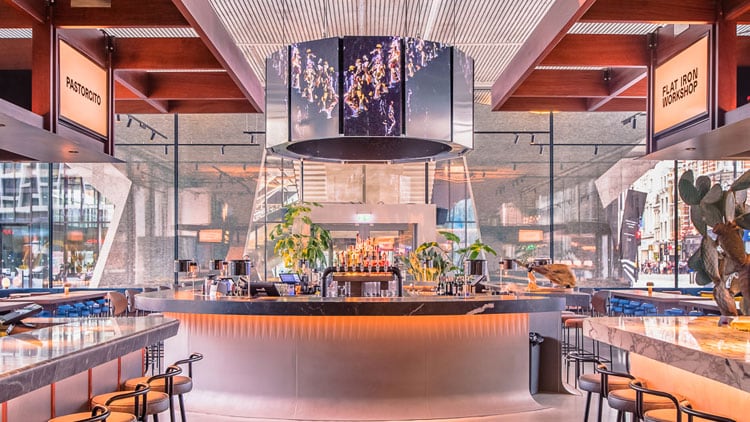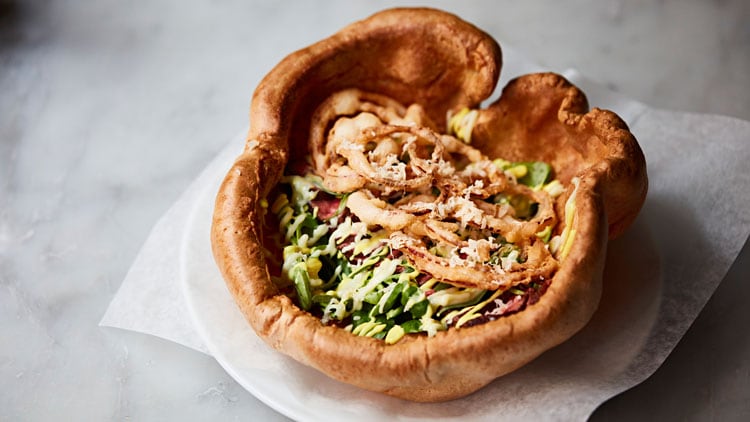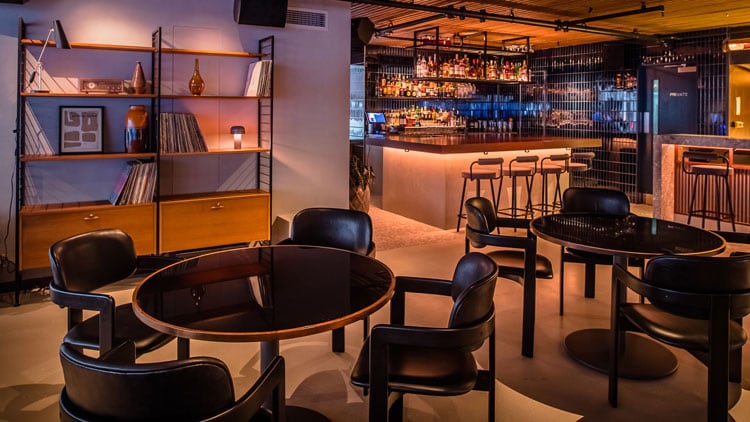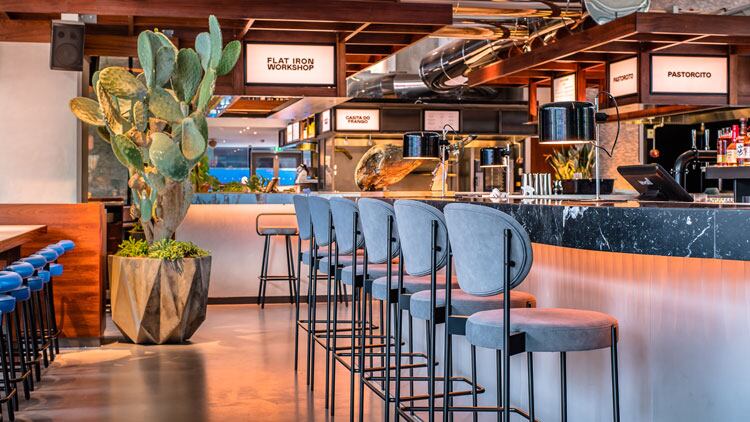There are plenty of theatres in the West End of London, but there’s never been one quite like Arcade. Located on the ground floor of the Centre Point building, next to Tottenham Court Road Tube station, it’s a playhouse, of sorts, where the drama is designed to unfurl behind the counters of the Theatre’s seven open-plan kitchens.
It’s worth stating at the outset that, on the surface, the opening of yet another London-based food hall doesn’t appear to be particularly noteworthy. Especially given that later this year Simon Anderson and Andy Lewis Pratt are due to open their 37,500sq ft Market Halls West End site – dubbed the largest food hall in the country – just down the road.
The opening of Arcade Food Theatre is significant, though. Not only does it mark another stage in the growth of Centre Point’s food scene – Taiwanese restaurant brand Din Tai Fung’s second London site is expected to launch there later this year – it also, arguably, represents the next evolutionary phase in the growth of food-hall style operations in the capital; shifting away from the traditional street food model and instead looking towards London’s burgeoning restaurant scene.
It was London venues Hawker House and Dinerama that created the blueprint for food halls not only in the capital, but across the country; bringing together the best street food operators in the area under one roof, sticking in a couple of bars, and watching the magic unfold. In the years that followed, the concept has been cultivated by the likes of Market Halls in London (which already operates sites in Fulham and Victoria) and further afield by Colindale’s pan-Asian food court Bang Bang Oriental, the Altrincham Market and Mackie Mayor in Manchester, and the Duke Street Food and Drink Market in Liverpool.

At first glance, Arcade appears to adhere closely to that traditional food hall blueprint. Spread across a 12,500sq ft, Grade II-listed space, it features six independent, ground floor kitchens with another on an upper level; a coffee and bakery counter; a number of ‘conceptualised’ bar areas serving a premium selection of beers, wine and cocktails; and, of course, an outdoor terrace.
Its appearance is smarter
than you would expect to find
in your standard food hall
Look closely, however, and you’ll notice that there’s more to Arcade than initially meets the eye. For a start, there’s something different about the traders. In lieu of the usual street food suspects, there is an eclectic mix of restaurant names that will undoubtedly be familiar to most London-based foodies, with Italian restaurant and deli company Lina Stores, Japanese-Peruvian fusion brand Chotto Matte, and steak slingers Flat Iron all taking up residency.
What’s more, rather than simply replicating the menus available at their bricks and mortar sites, some of the traders have tweaked their concepts, with the Arcade team encouraging its restaurant partners to experiment with new dish ideas and menu frameworks.

As such, Flat Iron is operating its own ‘Workshop’, where chefs can play around with different meal concepts that at launch include a steak and Yorkshire plate that features steak cooked over a bespoke holm oak-fired grill, served in a giant, beef dripped-Yorkshire pudding and topped with pickled Tropea onions, English mustard mayonnaise and fresh horseradish; and the charcoal-grilled Featherblade tip, a new cut created especially by Flat Iron for its Arcade site.
Upstairs, meanwhile, sits The Loft, an ‘incubation-focused mezzanine space’ that’s been designed by interior architects Macaulay Sinclair – as all of Arcade has – to showcase emerging culinary talent in the capital beginning with TOU, the new katsu sando concept created by TaTa Eatery founders Ana Gonçalves and Zijun Meng. As with the Flat Iron team, Gonçalves and Meng say they plan to use the space to develop different ideas, with the current menu only featuring three sandwiches including the now Insta-famous Iberian katsu sando of slow-cooked and deep-fried pork neck, served on a bed of shredded cabbage and raspberry brown sauce between slices of toasted brioche.

In contrast, other traders appear to have stuck closer to their roots. The team behind Algarvian restaurant Casa do Frango has created a small-scale offshoot to the original concept – appropriately named Casita Do Frango – that continues to focus on piri-piri barbecue chicken; while both Selin Kiazim and Laura Christie’s Turkish concept Oklava, and Kurt Zdesar’s Chotto by Chotto Matte will both initially serve reduced versions of the menus available at their respective permanent restaurants.
The team behind Arcade says that while it drew a lot of its inspiration from the food hall model, what it ultimately wants to create with Arcade is a platform where the theatrical elements of chef-led, destination dining are elevated through kitchen counter seating that encourages interaction between chefs and diners. It also pays closer attention to music, art and design than other food halls – above the main bar hangs a large-scale video installation by artist Marco Brambilla, one of a number of commissioned art installations from internationally-renowned galleries that are expected to appear there.
There's more to Arcade
than meets the eye
Arcade’s appearance is certainly smarter than you would expect to find in your standard food hall. A mix of soft wooden hues and dark marble shades enhance the brightly-lit downstairs dining area, which features long communal tables and extensive seating; while the low lighting and quieter acoustics upstairs offer diners looking to escape the hustle and bustle of the West End a more intimate space to retreat to.
In the years to come, London’s food hall scene will continue to grow at pace. Next year Bishopsgate is set to see both hospitality group Rhubarb and Italian food hall brand Eataly’s open sites there, and in 2021 Waterloo will house the 32,500sq ft Time Out Market. What Arcade appears to offer though, is a comfortable alternative to this booming movement that may even, perhaps, make London’s evermore-saturated restaurant scene slightly more exciting.
Whether it’s a sustainable model in the long run remains to be seen, but on first impressions it certainly feels like a vision worthy of a standing ovation.

